
eBook - ePub
Old Brooklyn in Early Photographs, 1865-1929
William Lee Younger
This is a test
Condividi libro
- 165 pagine
- English
- ePUB (disponibile sull'app)
- Disponibile su iOS e Android
eBook - ePub
Old Brooklyn in Early Photographs, 1865-1929
William Lee Younger
Dettagli del libro
Anteprima del libro
Indice dei contenuti
Citazioni
Informazioni sul libro
157 photographs, many never before reprinted, show the vitality and variety of old Brooklyn, Manhattan's first suburb: waterfront, Brooklyn Bridge, Fulton Street, Brooklyn Heights, Ebbets Field, Luna Park, Gravesend Race Track, Sheepshead Bay, Manhattan Beach Hotel, and more from the Long Island Historical Society collection.
Domande frequenti
Come faccio ad annullare l'abbonamento?
È semplicissimo: basta accedere alla sezione Account nelle Impostazioni e cliccare su "Annulla abbonamento". Dopo la cancellazione, l'abbonamento rimarrà attivo per il periodo rimanente già pagato. Per maggiori informazioni, clicca qui
È possibile scaricare libri? Se sì, come?
Al momento è possibile scaricare tramite l'app tutti i nostri libri ePub mobile-friendly. Anche la maggior parte dei nostri PDF è scaricabile e stiamo lavorando per rendere disponibile quanto prima il download di tutti gli altri file. Per maggiori informazioni, clicca qui
Che differenza c'è tra i piani?
Entrambi i piani ti danno accesso illimitato alla libreria e a tutte le funzionalità di Perlego. Le uniche differenze sono il prezzo e il periodo di abbonamento: con il piano annuale risparmierai circa il 30% rispetto a 12 rate con quello mensile.
Cos'è Perlego?
Perlego è un servizio di abbonamento a testi accademici, che ti permette di accedere a un'intera libreria online a un prezzo inferiore rispetto a quello che pagheresti per acquistare un singolo libro al mese. Con oltre 1 milione di testi suddivisi in più di 1.000 categorie, troverai sicuramente ciò che fa per te! Per maggiori informazioni, clicca qui.
Perlego supporta la sintesi vocale?
Cerca l'icona Sintesi vocale nel prossimo libro che leggerai per verificare se è possibile riprodurre l'audio. Questo strumento permette di leggere il testo a voce alta, evidenziandolo man mano che la lettura procede. Puoi aumentare o diminuire la velocità della sintesi vocale, oppure sospendere la riproduzione. Per maggiori informazioni, clicca qui.
Old Brooklyn in Early Photographs, 1865-1929 è disponibile online in formato PDF/ePub?
Sì, puoi accedere a Old Brooklyn in Early Photographs, 1865-1929 di William Lee Younger in formato PDF e/o ePub, così come ad altri libri molto apprezzati nelle sezioni relative a Arte e Historia de la fotografía. Scopri oltre 1 milione di libri disponibili nel nostro catalogo.
Informazioni
Argomento
ArteCategoria
Historia de la fotografíaIII
DOWNTOWN BROOKLYN & ADJACENT AREAS
Starting from Borough Hall, this section moves southeast down Fulton Street, taking in a few areas a little north and south of that artery, then covers the area just to the west of Borough Hall, and concludes with a few sites extending north of Borough Hall as far up as the foot of Brooklyn Bridge. Also included are two out-of-Brooklyn views associated with Namm’s on Fulton Street and the Long Island Rail Road depot on Flatbush Avenue.
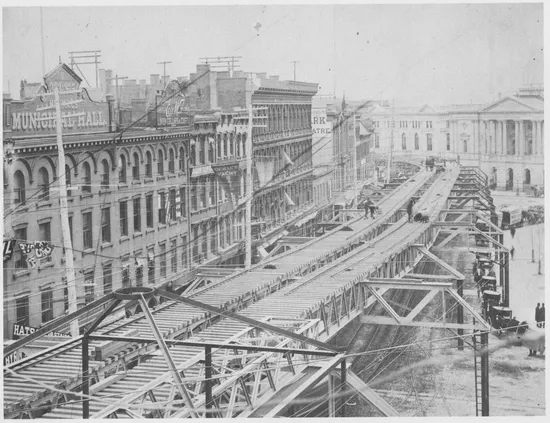
22. FULTON STREET, CA. 1887. The carriages and wagons waiting around City Hall (now Borough Hall) are dwarfed by the new Kings County Elevated Railroad as it nears completion in 1887. The buildings in the right background on Joralemon Street are the Hall of Records and the County Court House (with barely visible dome). At the left is a busy commercial stretch of Fulton Street. Mechanics Municipal Hall provided space where workingmen could assemble for meetings and self-improvement. The tall building in the center is the Arbuckle Building (once Dieter’s Hotel, where terrapin was a specialty) and beyond it is the Park Theatre. The el was taken down in the early 1940s, and the site at the left cleared in 1955 for the Supreme Court Building and Civic Center.
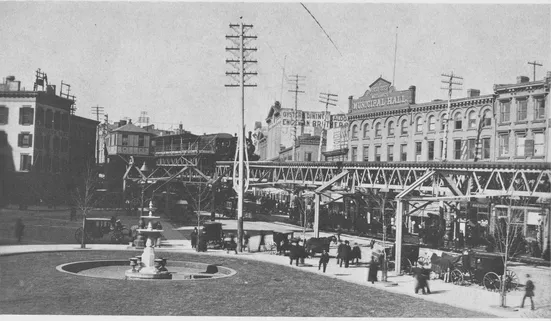
23. FULTON STREET AT CITY HALL PARK, 1890. This was one of Brooklyn’s busiest sections in the last quarter of the nineteenth century, a hub of commerce, transportation and government. This view looks northward toward the intersection of Fulton, Court and Washington Streets as a steam locomotive heads south on the Kings County Elevated Railroad.
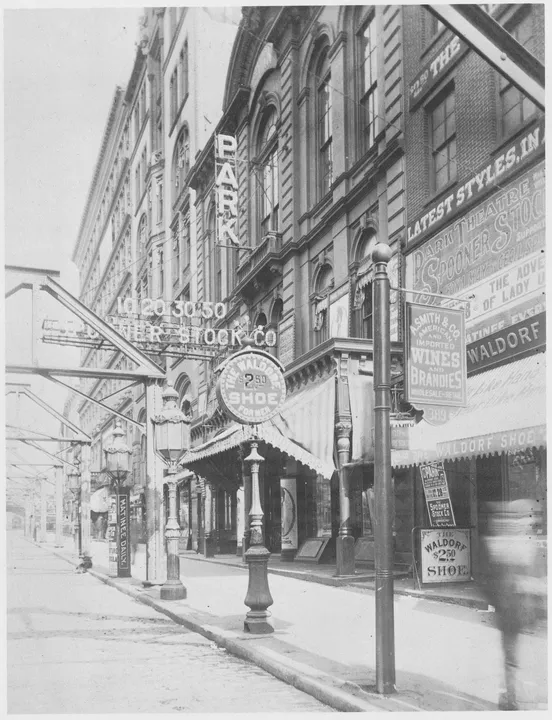
24. PARK THEATRE, FULTON STREET, NEAR JORALEMON STREET, CA. 1902. Colonel William E. Sinn’s Park Theatre, opened in 1863, was one of Brooklyn’s most celebrated playhouses until destroyed by fire in 1908. It is photographed here amid a patchwork of signs, many of which are reminders of a past era when the top price of a seat in a neighborhood theater was 50 cents and a pair of shoes cost $2.50. At this time the popular Spooner Stock Company, under the direction of Mrs. Mary Gibbs Spooner (1855–1940), was appearing at the Park, where it endeared itself to Brooklyn theatergoers. At the left are the Germania Savings Bank and the Arbuckle Building.

25. CITY HALL (NOW BOROUGH HALL), FEBRUARY 26, 1895. On the morning of February 26, 1895, a fire broke out in the cupola of City Hall, an event captured in this rare photograph. The cupola was destroyed, as well as its bell and clock, both of which fell many floors below. The present cupola, designed by C. W. & A. A. Houghton, is a replacement of 1898. The building at the right, built in 1883 at the southwest corner of Court and Remsen Streets, was occupied by the Dime Savings Bank (now razed). Photo: Adrian Vanderveer Martense.

26. NAMM STORE, FULTON AND HOYT STREETS, 1898. This photograph suggests there was once a time when a customer in Namm’s shoe department had a clerk of his/her own sex. The saleswoman uses a button hook to unfasten her customer’s overgaiters before trying on a rather sensible shoe–definite-ly not the one advertised above her. Merchandise ran the gamut from fancy slippers to sturdy leggins, pairs of which hang at the right. The store was opened in New York by Adolph I. Namm in 1876. Ten years later, he moved it to Brooklyn, where it operated until 1957.
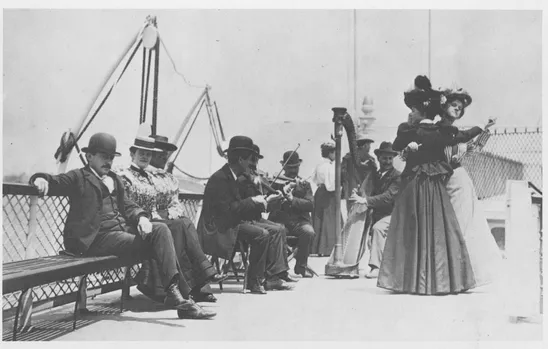
27. NAMM STORE’S EMPLOYEES’ EXCURSION, 1910. Daily cares are forgotten in this view taken aboard a Hudson River Day Line boat as it steams up the river toward Albany.
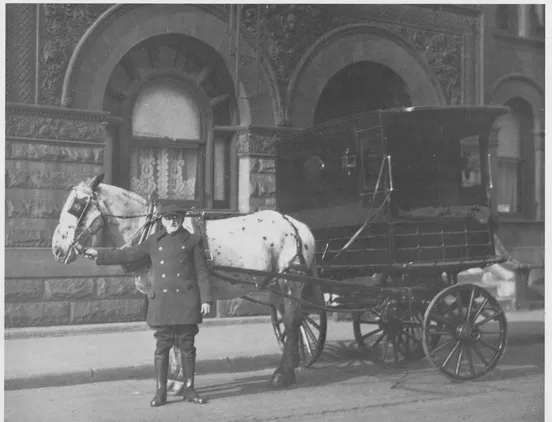
28. NAMM STORE’S LAST HORSE-DRAWN DELIVERY WAGON, CA. 1914. Long a familiar sight in Brooklyn’s residential sections, this mode of delivery was soon to give way to trucks. The architectural details of the unidentified building in the background are fine examples of the Romanesque Revival style popular in the last two decades of the nineteenth century.

29. GRAND OPERA HOUSE, ELM PLACE, CA. 1890. “Grand Opera House” was a frequent nineteenth-century name for any kind of theater, and did not necessarily imply lofty musical ideals. This one, in fact, was built in 1881 for Barry and Fay, two popular Irish variety actors of the period. To the right of the porch, rich with gingerbread, part of the A. I. Namm store is visible. At the far right is the Fulton Street el. By the early 20s, when the Opera House was pulled down for Namm’s expansion, it was featuring second-rate silent films. The annex of Abraham & Straus now occupies the site.

30. FULTON AND BOND STREETS, CA. 1902. William Wynn & Company, Chemists, prepare to vacate these premises, soon to be razed for the expansion of Frederick Loeser & Company, whose great store already looms behind this small commercial building. Loeser’s, whose motto was “In every detail the leading retail establishment in Brooklyn,” occupied the entire Fulton Street blockfront by 1903 and continued in business there until 1952. The smartly dressed delivery boy in this photograph was no doubt kept busy by both the pharmacist and the florist. Upstairs, Mrs. Tyler-Miller’s establishment featured private rooms for hairdressing and beauty treatments and the largest line of hair goods in Brookyn.
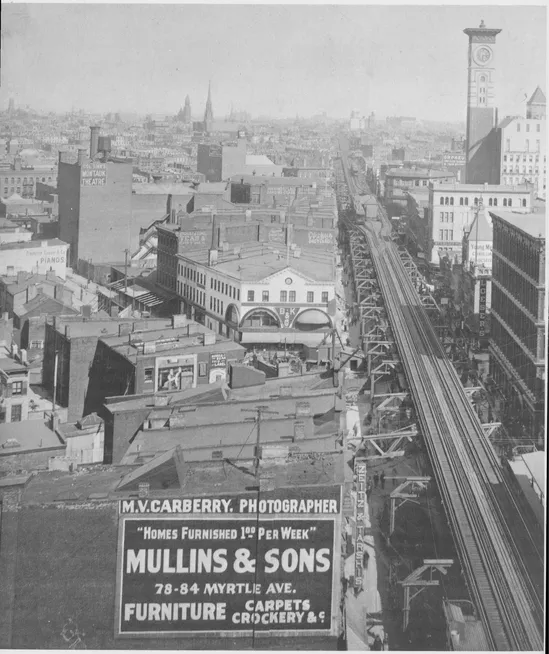

31. FULTON STREET AT DE KALB AVENUE, CA. 1905. The Fulton Street elevated tracks are seen stretching eastward through the heart of the shopping and theater district and into central Brooklyn. Frederick Loeser & Company, one of Brooklyn’s finest stores, is seen here at the corner of Bond Street. The clock tower, visible at that time from many parts of the city, was atop the Fulton and Flatbush Storage Company at Nevins Street. The sign “B. K. & Co.” (Browning King & Company, clothiers) is at the intersection of Fulton and De Kalb Avenue, near the present Dime Savings Bank.
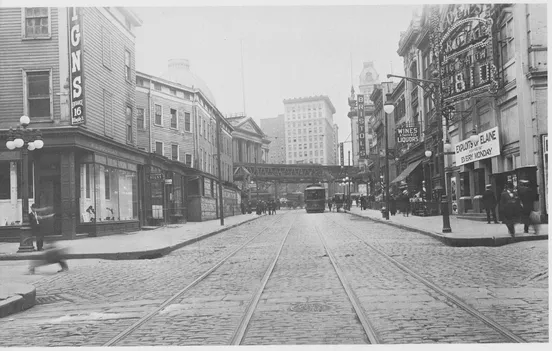
32. WILLOUGHBY STREET, NEAR PEARL STREET, 1915. This picture of the downtown area was taken looking west with the structure of the Fulton Street elevated in the distance. The Terminal Building at the center, a new office building when this view was made, is at 50 Court Street. The domed building at the left, its classical beauty in sharp contrast to the old wooden houses that partially conceal it, is the County Court House. Here Loew’s Royal Theatre is featuring a popular serial in addition to its “big show.”
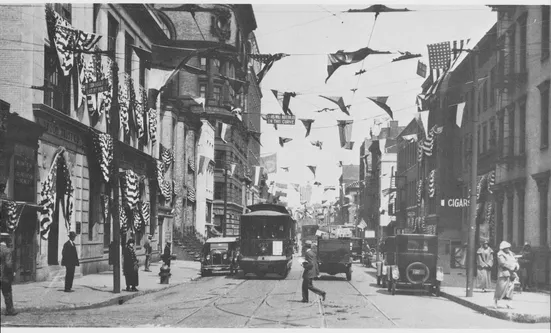
33. WILLOUGHBY STREET AT JAY STREET, CA. 1920. A sign warns cars not to pass on this curve of busy Willoughby Street, where a holiday spirit is evident. Although two men are wearing straw ...